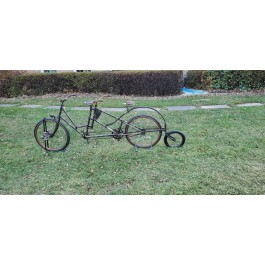|
|
1898 Rex Tandem BicycleDescriptionPart of the collection of Harry Kraemer's bicycle collection.This is an original nickel plated frame. Most of the nickel plating is gone. Mel Short rebuilt this bike. It is all period correct. This bike is fully functional and can be ridden. Click here for a slideshow of other vehicles in the collection Award history: 2022 People's Choice Award - Simple Transport 15 August 20 Top 5 Bicycle Award - Simple Transport 15 August 20 Click here for pictures of vintage Rex Cycle Co ads Click here for bicycles similar to the Rex Click here for info on other inline 3 wheelers Click here for info on our Rex single seat bicycle In many tandem bicycles of this period, the lady rode in front. Do you know why? Before the 1890s, the bicycle was a vastly different vehicle and was by no means popular. Between the 1860s and the mid-1880s, the standard bicycle was the ordinary or high wheeler, which was both hard to master and dangerous to use. While the ordinary was exclusively used by men, women were allowed to use bicycles such as the two-seater sociable, the tandem, and the tricycle. Beginning in the late 1860s companionate riding became a popular social activity for men and women. These vehicles allowed men and women to develop new methods of coed socialization. However, up until the mid 1880s, women were primarily dependent upon men in order to participate in cycling. The presence of a man in control of the sociable assumed that the man could keep the woman safe from the dangers of riding a bike alone, thereby assuming the authority of man. So while companionate riding was revolutionary in the development in sociability between men and women, it kept women in an inferior position to men by assuming that the man had the power over the bicycle in that situation. Equipment Specifications
Detailed Information
|












